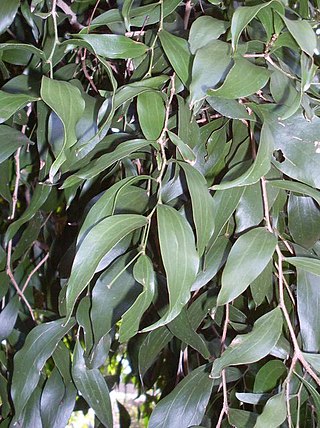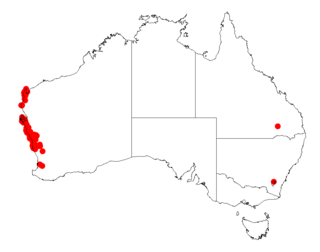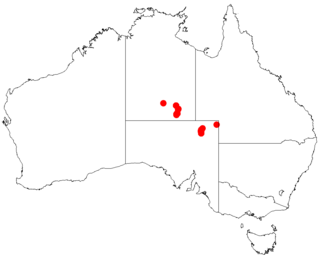
Acacia longifolia is a species of Acacia native to southeastern Australia, from the extreme southeast of Queensland, eastern New South Wales, eastern and southern Victoria, southeastern South Australia, and Tasmania. Common names for it include long-leaved wattle, acacia trinervis, aroma doble, golden wattle, coast wattle, sallow wattle and Sydney golden wattle. It is not listed as being a threatened species, and is considered invasive in Portugal, New Zealand and South Africa. In the southern region of Western Australia, it has become naturalised and has been classed as a weed by out-competing indigenous species. It is a tree that grows very quickly reaching 7–10 m in five to six years.

Acacia acinacea, commonly known as gold dust wattle, is a flowering shrub. It is native to south eastern Australia and lives for 15 years on average. This wattle species is tolerant of drought and frost. It is also known as wreath wattle or round-leaf wattle.

Acacia verticillata is a perennial shrub to small tree native to south eastern Australia.

Acacia myrtifolia, known colloquially as myrtle wattle, red stem wattle or red-stemmed wattle, is a species of Acacia native to coastal areas of southern and eastern Australia.

Acacia bakeri, known as the marblewood, white marblewood, Baker's wattle or scrub wattle, is one of the largest of all acacias, growing to 40 m (130 ft) tall. It is a long-lived climax rainforest tree from eastern Australia. Unlike most acacias, fire is not required for seed germination. This tree is considered vulnerable to extinction. Its former habitat is lowland sub tropical rainforest which has been mostly cleared in the 19th and 20th centuries.

Acacia hispidula, known colloquially as little harsh acacia, rough-leaved acacia or rough hairy wattle, is a species of Acacia native to eastern Australia.

Acacia willdenowiana is a shrub belonging to the genus Acacia. The plant is also commonly known as wattle grass, grass wattle or two-winged acacia. It is native to the south west of Western Australia.

Acacia georgensis, commonly known as Bega wattle or Dr George Mountain wattle, is a species of Acacia native to southeastern Australia. It was one of eleven species selected for the Save a Species Walk campaign in April 2016 when scientists walked 300 km to raise money for collection of seeds to be prepared and stored at the Australian PlantBank at the Australian Botanic Garden Mount Annan.

Acacia robiniae, commonly known as Robin's wattle, is a shrub of the genus Acacia and the subgenus Phyllodineae that is endemic to south western Australia.

Acacia ryaniana is a shrub of the genus Acacia and the subgenus Phyllodineae that is endemic to an area along the west coast of Australia.

Acacia spathulifolia commonly known as Gold carpet or the Gold carpet wattle is a shrub of the genus Acacia and the subgenus Phyllodineae that is endemic to coastal parts of western Australia.

Acacia pharangites, commonly known as Wongan gully wattle, is a shrub of the genus Acacia and the subgenus Plurinerves that is endemic to the Wongan Hills of south western Australia and is listed as endangered according to the Environment Protection and Biodiversity Conservation Act 1999.

Acacia sulcata is a shrub of the genus Acacia and the subgenus Plurinerves that is endemic to an area of south western Australia.

Acacia subtilinervis, also known as the net-veined wattle, is a rare wattle in the Juliflorae subgenus found in eastern Australia.

Acacia juncifolia, commonly known as rush-leaf wattle, is a shrub or tree belonging to the genus Acacia and the subgenus Phyllodineae that is endemic to north eastern Australia.

Acacia pickardii, commonly known as Pickard's wattle or birds nest wattle, is a tree or shrub belonging to the genus Acacia and the subgenus Phyllodineae native to eastern Australia. It is listed as a vulnerable species according to Environment Protection and Biodiversity Conservation Act 1999.

Acacia siculiformis, commonly known as dagger wattle, is a shrub belonging to the genus Acacia and the subgenus Phyllodineae native to south eastern Australia.

Acacia kybeanensis, commonly known as kybean wattle or kybeyan wattle, is a shrub of the genus Acacia and the subgenus Phyllodineae that is endemic to south eastern Australia.

Acacia microcarpa, commonly known as manna wattle, is a shrub belonging to the genus Acacia and the subgenus Phyllodineae endemic to south eastern Australia.

Acacia mountfordiae, commonly known as Mountford's wattle, is a shrub or tree belonging to the genus Acacia and the subgenus Juliflorae that is native to north Australia.






















